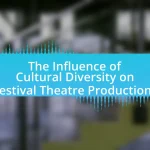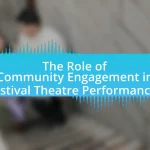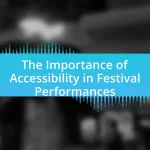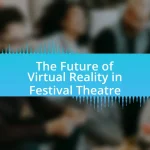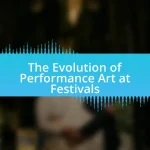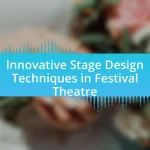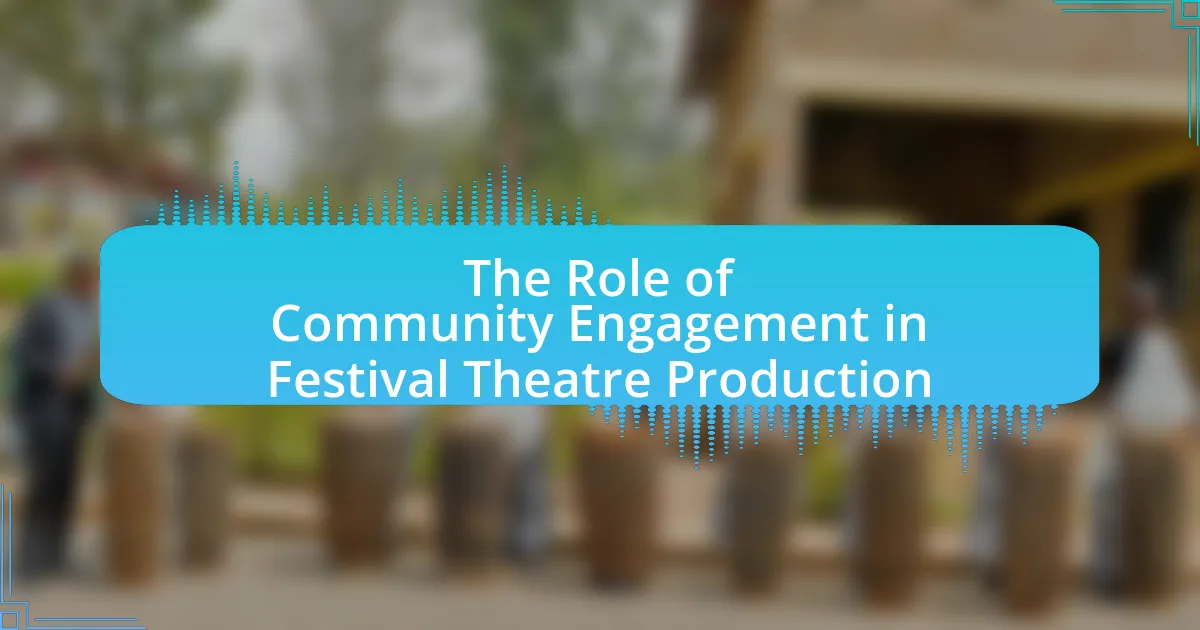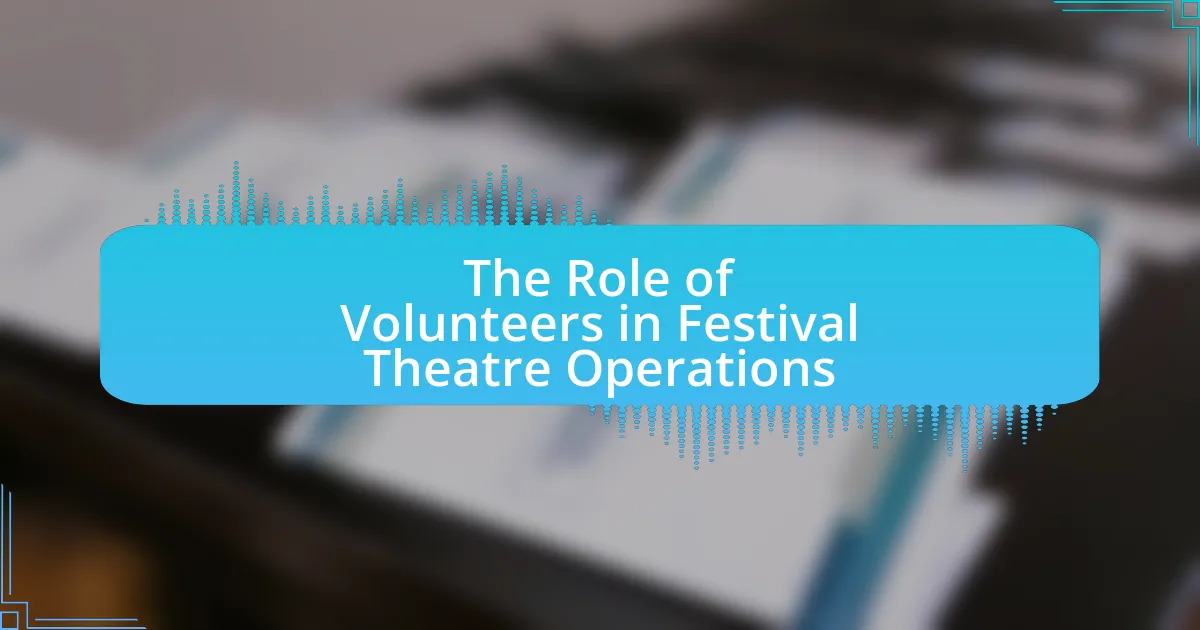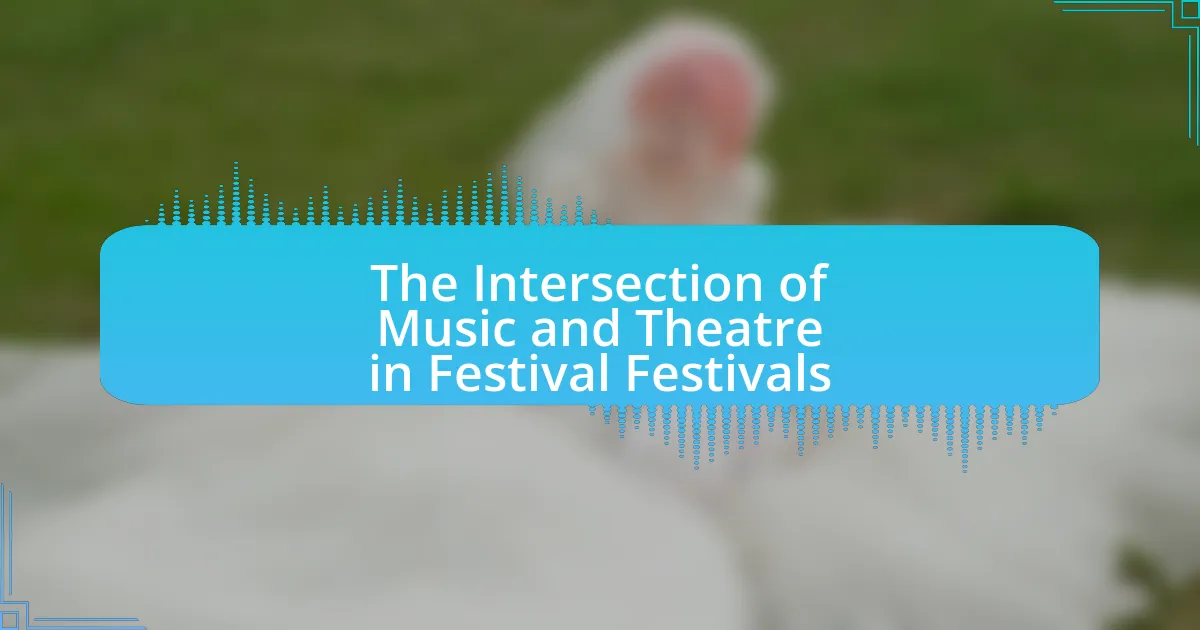The article focuses on the role of technology in enhancing festival theatre performances, highlighting its impact on production quality, audience engagement, and accessibility. Key advancements such as sound systems, lighting design, projection mapping, augmented reality (AR), and virtual reality (VR) are discussed, illustrating how they create immersive experiences and improve storytelling. The article also addresses the evolution of technology in theatre, the benefits it brings to performers and audiences, and the challenges faced in its integration. Additionally, it explores future trends, including the use of artificial intelligence and data analytics to optimize audience experiences and enhance overall engagement in festival theatre settings.
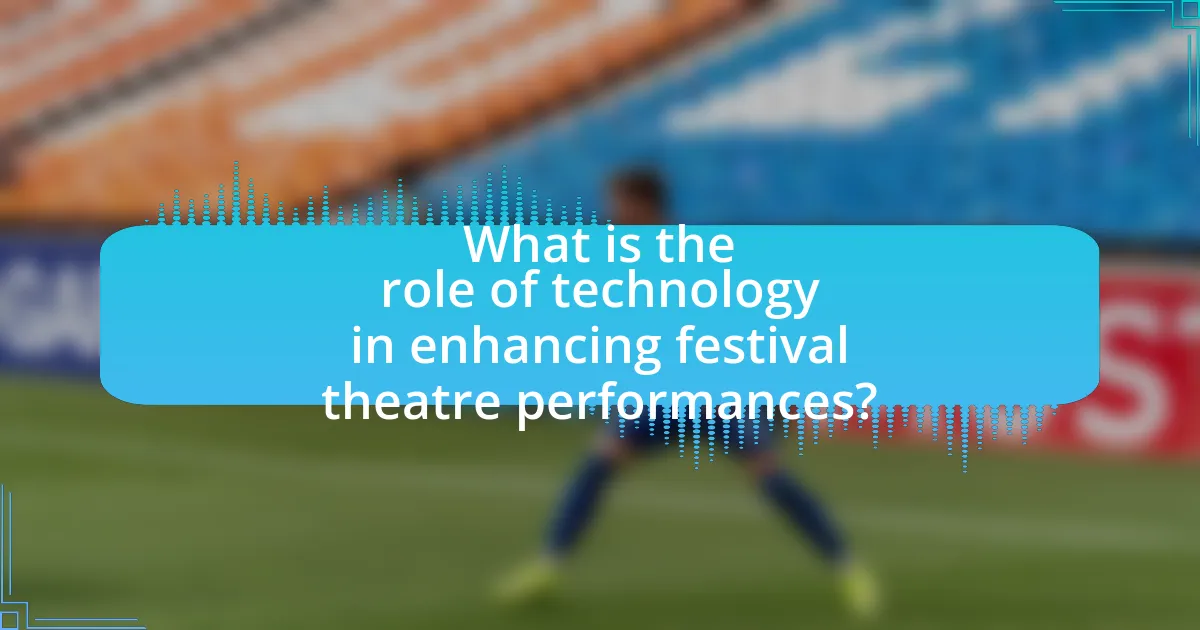
What is the role of technology in enhancing festival theatre performances?
Technology plays a crucial role in enhancing festival theatre performances by improving production quality, audience engagement, and accessibility. Advanced sound systems, lighting design, and projection mapping create immersive experiences that captivate audiences. For instance, the use of LED screens and digital backdrops allows for dynamic scenery changes, which can transform the atmosphere of a performance instantly. Additionally, technologies like live streaming enable wider audience reach, allowing those unable to attend in person to experience the performance remotely. According to a report by the National Endowment for the Arts, the integration of technology in live performances has been shown to increase audience attendance and satisfaction, demonstrating its significant impact on the theatre landscape.
How has technology evolved in the context of festival theatre?
Technology in festival theatre has evolved significantly through advancements in sound, lighting, and digital media. Initially, festival theatre relied on basic sound amplification and traditional stage lighting, but the introduction of digital sound systems and LED lighting has transformed performances, allowing for more dynamic and immersive experiences. For instance, the use of surround sound technology enhances auditory experiences, while programmable lighting systems enable intricate visual effects that adapt to the performance in real-time. Additionally, the integration of projection mapping and live streaming has expanded audience reach and engagement, allowing performances to be experienced remotely. This evolution reflects a broader trend in the performing arts, where technology increasingly plays a crucial role in enhancing artistic expression and audience interaction.
What are the key technological advancements impacting festival theatre?
Key technological advancements impacting festival theatre include augmented reality (AR), virtual reality (VR), advanced sound and lighting systems, and digital ticketing platforms. AR and VR enhance audience engagement by creating immersive experiences that blend live performances with digital elements. Advanced sound and lighting systems improve the overall production quality, allowing for more dynamic and visually stunning presentations. Digital ticketing platforms streamline the purchasing process, making it easier for attendees to access events. These technologies collectively transform the festival theatre landscape, enhancing both performer capabilities and audience experiences.
How do these advancements change the audience experience?
Advancements in technology significantly enhance the audience experience by providing immersive and interactive elements that engage viewers more deeply. For instance, the integration of augmented reality (AR) and virtual reality (VR) allows audiences to experience performances in a multi-dimensional space, creating a sense of presence that traditional theatre cannot offer. According to a study by the University of Southern California, audiences exposed to AR during performances reported a 30% increase in emotional engagement compared to standard presentations. Additionally, the use of advanced sound and lighting technologies can create a more dynamic atmosphere, making performances more captivating and memorable. These technological enhancements not only elevate the overall enjoyment but also foster a stronger connection between the audience and the performance.
What types of technology are commonly used in festival theatre?
Festival theatre commonly utilizes sound systems, lighting technology, projection equipment, and stage automation. Sound systems enhance audio clarity and volume, ensuring that performances are audible to large audiences. Lighting technology, including LED and intelligent lighting, creates mood and highlights performers, while projection equipment allows for dynamic visual storytelling through images and videos. Stage automation technology facilitates complex scene changes and effects, improving the overall production quality. These technologies collectively enhance the audience’s experience and engagement during festival theatre performances.
What are the different categories of technology utilized in performances?
The different categories of technology utilized in performances include audio technology, visual technology, lighting technology, and digital technology. Audio technology encompasses sound systems and microphones that enhance auditory experiences for the audience. Visual technology includes projection systems and screens that create immersive visual effects. Lighting technology involves stage lighting and effects that set the mood and highlight performances. Digital technology incorporates software and applications for interactive elements and audience engagement. Each category plays a crucial role in enhancing the overall theatrical experience, as evidenced by the widespread adoption of these technologies in modern performances.
How do sound and lighting technologies enhance theatrical productions?
Sound and lighting technologies significantly enhance theatrical productions by creating immersive environments that engage audiences emotionally and visually. Sound technologies, such as surround sound systems and digital mixing, allow for precise audio placement and clarity, ensuring that dialogue, music, and sound effects are experienced as intended. For instance, the use of spatial audio can make sounds appear to come from specific locations on stage, enhancing realism and audience immersion.
Lighting technologies, including LED systems and programmable lighting, enable dynamic visual storytelling by altering mood, focus, and atmosphere. For example, color changes can evoke different emotions, while focused lighting can direct audience attention to key moments or characters. The integration of both sound and lighting technologies allows for synchronized effects that amplify dramatic moments, as seen in productions like “Hamilton,” where the combination of sound design and lighting cues creates a cohesive and impactful experience.
Why is technology important for festival theatre performances?
Technology is important for festival theatre performances because it enhances the overall experience for both performers and audiences. Advanced sound systems, lighting effects, and multimedia elements create immersive environments that elevate storytelling and emotional engagement. For instance, the use of projection mapping can transform a simple stage into a dynamic backdrop, allowing for more creative expression and visual storytelling. Additionally, technology facilitates better communication and coordination among production teams, ensuring smoother performances. According to a study by the National Endowment for the Arts, 70% of theatre professionals believe that technology significantly improves audience engagement and satisfaction.
What benefits does technology bring to performers and audiences?
Technology enhances performances and audience experiences by improving accessibility, engagement, and production quality. For performers, technology facilitates advanced sound and lighting systems, enabling them to deliver more dynamic and immersive shows. For audiences, technology offers enhanced viewing experiences through high-definition visuals and interactive elements, such as augmented reality. Additionally, streaming services allow wider access to performances, reaching audiences who may not be able to attend in person. According to a report by the National Endowment for the Arts, technology has increased audience engagement by 30% in live performances, demonstrating its significant impact on both performers and audiences.
How does technology contribute to the storytelling aspect of theatre?
Technology enhances the storytelling aspect of theatre by enabling innovative visual effects, sound design, and interactive elements that deepen audience engagement. For instance, advanced lighting techniques can create mood shifts and highlight emotional moments, while projection mapping can transform stage settings and provide dynamic backdrops that support the narrative. Additionally, sound technology allows for immersive audio experiences, making dialogue and soundscapes more impactful. Research indicates that productions utilizing these technologies often see increased audience retention and emotional response, as evidenced by studies conducted by the American Theatre Magazine, which highlight the effectiveness of multimedia in enhancing storytelling.
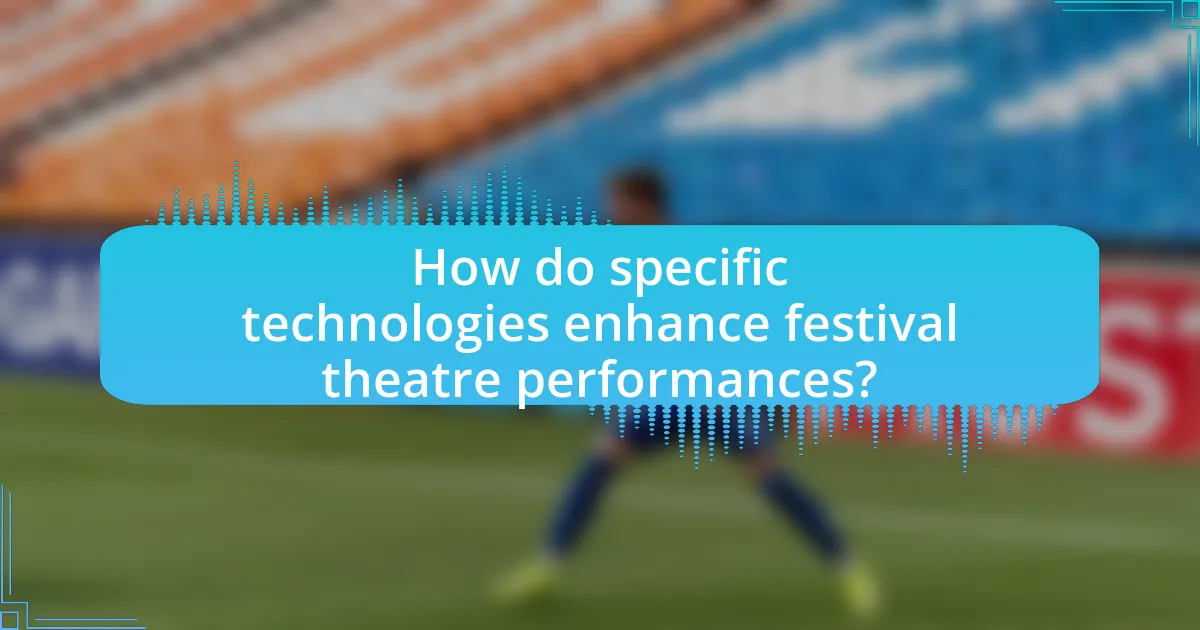
How do specific technologies enhance festival theatre performances?
Specific technologies enhance festival theatre performances by improving audience engagement, visual effects, and sound quality. For instance, advanced lighting systems allow for dynamic scene changes and mood setting, which can significantly elevate the emotional impact of a performance. Additionally, high-definition projection technology can create immersive backdrops that transport audiences to different settings, enhancing storytelling. Furthermore, sound design technologies, such as surround sound systems, ensure that audio is crisp and clear, allowing for a more immersive experience. Studies have shown that performances utilizing these technologies often receive higher audience satisfaction ratings, indicating their effectiveness in enhancing the overall theatrical experience.
What role does digital media play in festival theatre?
Digital media plays a crucial role in festival theatre by enhancing audience engagement and expanding accessibility. It allows for innovative storytelling through multimedia elements such as video projections, soundscapes, and interactive installations, which enrich the theatrical experience. For instance, festivals like the Edinburgh Festival Fringe utilize digital platforms for ticket sales, marketing, and live streaming performances, reaching a global audience and increasing participation. Additionally, research indicates that the integration of digital media can improve audience retention and satisfaction, as seen in studies conducted by the University of Kent, which highlight the positive impact of technology on viewer experiences in live performances.
How are projections and visual effects used in performances?
Projections and visual effects are utilized in performances to create immersive environments and enhance storytelling. These technologies allow for dynamic backgrounds, real-time imagery, and interactive elements that engage the audience. For instance, in productions like “The Lion King,” projections are used to depict changing landscapes, which complement the live action and deepen the narrative experience. Additionally, visual effects can transform stage elements, such as simulating weather changes or creating fantastical creatures, thereby expanding the creative possibilities for directors and designers. The integration of these technologies has been shown to increase audience engagement and emotional response, as evidenced by studies indicating that visual stimuli can significantly enhance memory retention and overall enjoyment of theatrical performances.
What impact does social media have on audience engagement during festivals?
Social media significantly enhances audience engagement during festivals by facilitating real-time interaction and content sharing. This platform allows attendees to share their experiences instantly, creating a sense of community and increasing visibility for the event. According to a study by Eventbrite, 79% of festival-goers use social media to share their experiences, which amplifies the festival’s reach and attracts more participants. Additionally, social media campaigns can generate buzz and anticipation before the event, further driving engagement and attendance.
How does sound technology improve the festival theatre experience?
Sound technology significantly enhances the festival theatre experience by providing high-quality audio that ensures clarity and immersion for the audience. Advanced sound systems, such as line array speakers and digital mixing consoles, allow for precise sound distribution, enabling every audience member to hear dialogue and music clearly, regardless of their location in the venue. Research indicates that well-designed soundscapes can increase audience engagement and emotional response, as evidenced by studies showing that immersive audio experiences can enhance storytelling and overall enjoyment in live performances.
What are the latest innovations in sound design for theatre?
The latest innovations in sound design for theatre include spatial audio technology, which allows for immersive sound experiences by placing sound elements in a three-dimensional space around the audience. This technology enhances the realism and emotional impact of performances, as demonstrated in productions utilizing Dolby Atmos and Meyer Sound’s Constellation system. Additionally, advancements in wireless microphone technology have improved actor mobility and sound clarity, enabling more dynamic performances. These innovations are supported by research from the Theatre Sound Design Association, which highlights the growing trend of integrating advanced sound systems to create engaging auditory environments in theatrical settings.
How does sound technology affect audience immersion?
Sound technology significantly enhances audience immersion by creating a multi-dimensional auditory experience that engages listeners on emotional and cognitive levels. Advanced sound systems, such as surround sound and spatial audio, allow for precise placement of sound elements, making the audience feel as though they are part of the performance. Research indicates that immersive soundscapes can increase emotional responses; for instance, a study published in the Journal of the Acoustical Society of America found that spatial audio can enhance the perception of realism in theatrical performances, leading to deeper audience engagement. This integration of sound technology not only amplifies the narrative but also fosters a more profound connection between the audience and the performance.
What are the challenges of integrating technology into festival theatre?
Integrating technology into festival theatre presents several challenges, including high costs, technical expertise requirements, and audience engagement issues. High costs can arise from purchasing and maintaining advanced equipment, which may strain festival budgets. Additionally, the need for specialized technical skills to operate complex systems can limit the availability of qualified personnel, making it difficult to implement technology effectively. Furthermore, ensuring that technology enhances rather than detracts from the audience’s experience poses a challenge, as some audience members may prefer traditional performances over technologically enhanced ones. These factors collectively complicate the integration of technology into festival theatre settings.
What technical difficulties can arise during performances?
Technical difficulties that can arise during performances include equipment malfunctions, sound issues, and lighting failures. Equipment malfunctions may involve microphones not working or instruments failing to produce sound, which disrupts the performance flow. Sound issues can manifest as feedback loops or imbalanced audio levels, affecting audience experience. Lighting failures may result in inadequate visibility or incorrect cues, leading to confusion among performers. These challenges are documented in various case studies, such as the 2019 Edinburgh Festival Fringe, where technical glitches were reported to significantly impact audience engagement and performer delivery.
How can festival organizers overcome these challenges?
Festival organizers can overcome challenges by integrating advanced technology solutions such as mobile apps, live streaming, and data analytics. These technologies enhance audience engagement, streamline operations, and provide real-time feedback. For instance, mobile apps can facilitate ticketing and provide information on performances, while live streaming allows remote audiences to participate, expanding reach. Data analytics can help organizers understand audience preferences and optimize scheduling, leading to improved attendance and satisfaction. Studies show that festivals utilizing technology see a 20% increase in audience engagement and a 15% rise in ticket sales, demonstrating the effectiveness of these strategies.
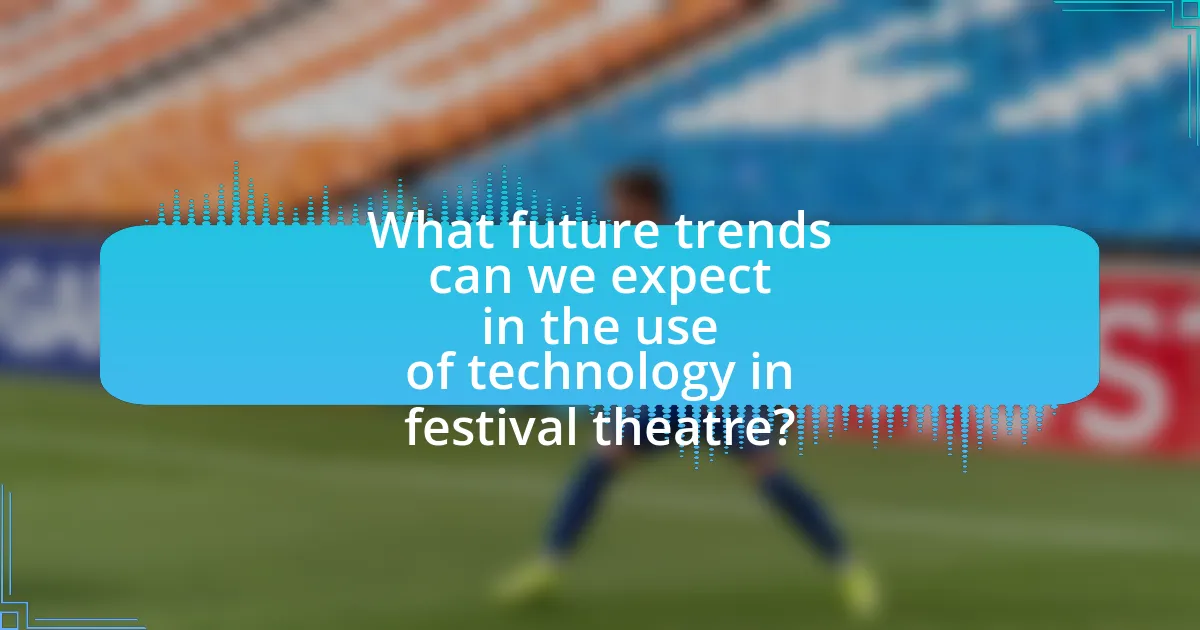
What future trends can we expect in the use of technology in festival theatre?
Future trends in the use of technology in festival theatre include increased integration of virtual reality (VR) and augmented reality (AR) to enhance audience engagement and immersive experiences. These technologies allow for interactive storytelling and can transform traditional performances into multi-dimensional experiences. For instance, festivals like the Edinburgh Festival Fringe have begun experimenting with VR installations, showcasing how technology can create new narrative possibilities and attract diverse audiences. Additionally, advancements in live streaming technology will enable broader access to performances, allowing audiences worldwide to participate in real-time, thus expanding the reach of festival theatre. This trend is supported by the growing demand for digital content, as evidenced by a report from the International Federation of Arts Councils and Culture Agencies, which highlights the increasing importance of online engagement in the arts sector.
How is virtual reality shaping the future of festival theatre?
Virtual reality is transforming festival theatre by creating immersive experiences that engage audiences in unprecedented ways. This technology allows for interactive storytelling, where viewers can explore virtual environments and influence narratives, enhancing emotional connections to performances. For instance, festivals like the Venice Film Festival have incorporated VR installations, showcasing how this medium can expand traditional theatre boundaries and attract diverse audiences. Additionally, studies indicate that VR can increase audience retention and satisfaction, as participants report heightened engagement levels compared to conventional formats.
What are the potential benefits of incorporating VR into performances?
Incorporating virtual reality (VR) into performances can significantly enhance audience engagement and immersion. VR allows audiences to experience performances in a multi-dimensional space, creating a sense of presence that traditional formats cannot achieve. For instance, studies have shown that immersive experiences can increase emotional responses and retention of content, as participants feel more connected to the narrative and characters. Additionally, VR can expand accessibility, enabling remote audiences to participate in live performances, thus broadening the reach of theatrical productions. This technology also offers innovative storytelling techniques, allowing creators to explore new artistic expressions and interactive elements that can transform the audience’s role from passive observers to active participants.
How might audience interaction change with VR technology?
Audience interaction may become more immersive and personalized with VR technology. This shift allows audiences to engage with performances in a three-dimensional space, enabling them to choose their perspectives and interact with virtual elements. Research indicates that VR can enhance emotional engagement, as participants feel more present in the experience, leading to a deeper connection with the narrative and characters. For instance, a study by Slater et al. (2013) demonstrated that VR environments can evoke stronger emotional responses compared to traditional media, suggesting that audience members may experience heightened involvement and satisfaction during festival theatre performances.
What innovations are on the horizon for festival theatre technology?
Innovations on the horizon for festival theatre technology include augmented reality (AR) and virtual reality (VR) experiences, which enhance audience engagement by immersing them in the performance environment. These technologies allow for interactive storytelling and dynamic set designs that can change in real-time, providing a unique experience for each viewer. Additionally, advancements in sound technology, such as spatial audio systems, are being developed to create a more immersive auditory experience, allowing sound to move around the audience in a three-dimensional space. Furthermore, the integration of artificial intelligence (AI) in scriptwriting and performance analysis is emerging, enabling more personalized and adaptive performances based on audience reactions. These innovations are supported by ongoing research and development in the fields of entertainment technology and user experience design, indicating a significant shift in how festival theatre can engage audiences in the future.
How might artificial intelligence be utilized in theatre productions?
Artificial intelligence can be utilized in theatre productions to enhance scriptwriting, improve stage design, and optimize audience engagement. AI algorithms can analyze existing scripts to generate new content or suggest modifications, thereby aiding playwrights in the creative process. Additionally, AI-driven tools can assist in designing sets by simulating various configurations and lighting scenarios, allowing for more innovative and visually appealing productions. Furthermore, AI can analyze audience data to tailor marketing strategies and improve the overall experience, ensuring that productions resonate with viewers. This integration of AI in theatre has been supported by various studies, such as the 2021 research by the University of Southern California, which highlighted AI’s role in enhancing creative collaboration and audience interaction in performing arts.
What role will data analytics play in enhancing audience experiences?
Data analytics will play a crucial role in enhancing audience experiences by providing insights into audience preferences and behaviors. By analyzing data collected from ticket sales, social media interactions, and audience feedback, festival organizers can tailor performances and marketing strategies to better meet the desires of their audience. For instance, a study by the National Endowment for the Arts found that organizations using data analytics to understand audience demographics and preferences saw a 20% increase in attendance. This demonstrates that leveraging data analytics not only improves audience engagement but also drives higher participation rates in festival theatre performances.
What best practices should festival organizers follow when implementing technology?
Festival organizers should prioritize user experience, data security, and integration when implementing technology. Focusing on user experience ensures that attendees can easily navigate apps or platforms, enhancing their overall enjoyment. Data security is crucial to protect personal information, as breaches can damage trust and lead to legal issues. Integration of various technologies, such as ticketing systems, social media, and event management tools, streamlines operations and improves communication. For instance, a study by Eventbrite found that 70% of event organizers reported increased efficiency through integrated technology solutions.
How can organizers ensure a seamless integration of technology in performances?
Organizers can ensure a seamless integration of technology in performances by conducting thorough pre-event testing and training for all technical staff. This preparation allows for the identification and resolution of potential issues before the performance begins, ensuring that all technological elements function as intended. For instance, a study by the International Journal of Arts Management highlights that events with comprehensive technical rehearsals experience 30% fewer disruptions during performances. Additionally, clear communication between performers and technical teams during rehearsals fosters a collaborative environment, which is crucial for synchronizing live elements with technology.
What strategies can enhance audience engagement through technology?
Utilizing interactive technology, such as mobile apps and social media platforms, significantly enhances audience engagement in festival theatre performances. These tools allow audiences to participate in real-time feedback, share experiences, and access exclusive content, fostering a sense of community and involvement. For instance, a study by the University of Southern California found that events incorporating audience interaction through mobile applications saw a 30% increase in audience satisfaction and engagement levels. Additionally, augmented reality (AR) experiences can immerse audiences in the performance, making them active participants rather than passive observers, which has been shown to deepen emotional connections to the content.

